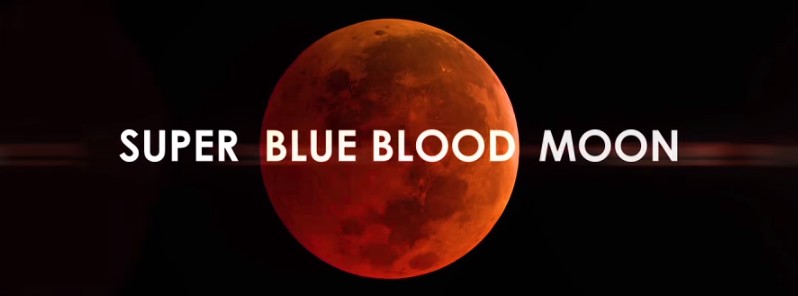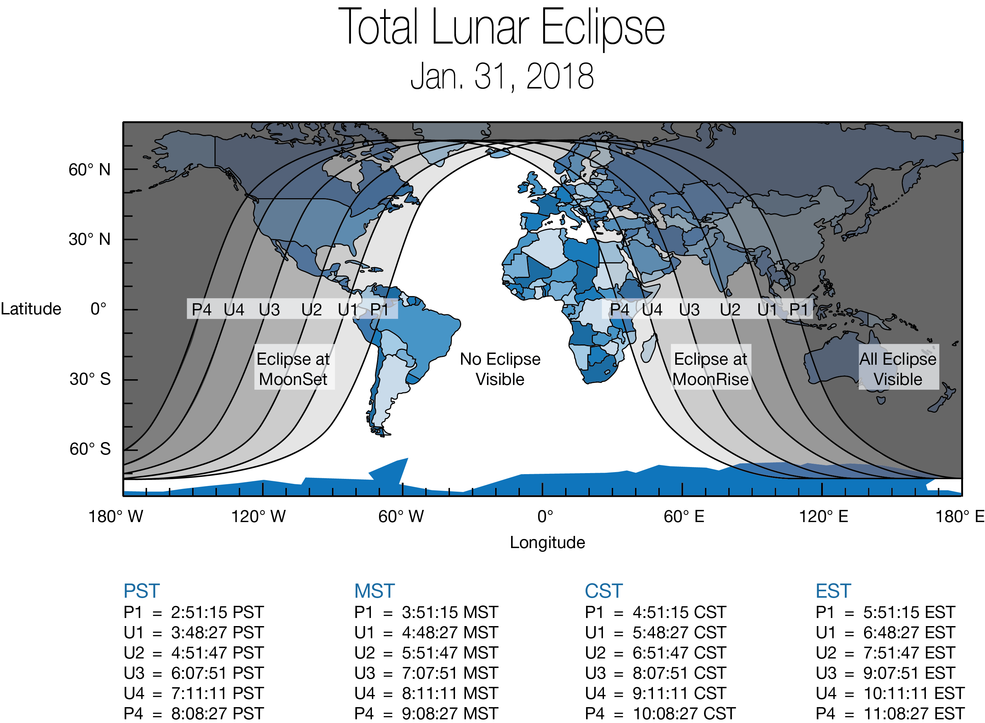Super blue blood Moon and total lunar eclipse on January 31, 2018

A rare astronomical event will take place on January 31, 2018 – the third in a series of supermoons, the second full moon of the month known as the blue moon and a total lunar eclipse which will make the Moon take on a reddish tint, known as a 'blood moon.'
The Moon will make its closest approach to the Earth at 13:28 UTC on January 31, making this day a truly special one with a full moon, a supermoon, a blue moon and a total lunar eclipse, visible from Asia, Australia, Pacific, western North America.
The instant of greatest eclipse will take place at 03:31 UTC. At that time, while the Moon is in the Earth’s shadow, it will take on a reddish tint, known as a 'blood moon.'
How rare is this?
While the last blue moon total lunar eclipse visible from the United States and North America took place on March 31, 1866, the last time a total lunar eclipse took place during a blue moon was on December 30, 1982 and was visible over Europe, Africa and western Asia. The last supermoon total eclipse occurred on September 2015.
Eclipse visibility
If you live in North America, Alaska, or Hawaii, the eclipse will be visible before local sunrise on January 31, while those in the Middle East, Asia, eastern Russia, Australia and New Zealand, the 'super blue blood moon' can be seen during moonrise in the evening of the 31st.

Global map showing areas of the world that will experience (weather permitting) the January 31, 2018 'super blue blood moon.' The eclipse will be visible before sunrise on January 31 for those in North America, Alaska and Hawaii. For those in the Middle East, Asia, eastern Russia, Australia and New Zealand, the super blue blood moon can be seen during moonrise the evening of the 31st. Credit: NASA
NASA's Gordon Johnston said the West Coast, Alaska and Hawaii will have a spectacular view of totality from start to finish, weather permitting. "Unfortunately, eclipse viewing will be more challenging in the Eastern time zone. The eclipse begins at 05:51 EST, as the Moon is about to set in the western sky, and the sky is getting lighter in the east."
"The darker part of Earth’s shadow will begin to blanket part of the Moon with a reddish tint at 06:48 EST, but the Moon will set less than a half-hour later. So your best opportunity if you live in the East is to head outside about 06:45 and get to a high place to watch the start of the eclipse – make sure you have a clear line of sight to the horizon in the west-northwest, opposite from where the Sun will rise," Johnston said.
Viewing will be better for those living in the Central time zone. At 04:51 CST the penumbra, or lighter part of Earth’s shadow, will touch the Moon. By about 06:15 CST the Earth's reddish shadow will be clearly noticeable on the Moon. The eclipse will be harder to see in the lightening pre-dawn sky, and the Moon will set after 07:00 as the Sun rises. "If you live in Kansas City or Chicago, your best viewing will be from about 06:15 – 06:30 CST. Again, you’ll have more success if you can go to a high place with a clear view to the West," Johnson said.
The show in the Rocky Mountain region begins as the umbra touches the edge of the Moon at 04:48 MST and the peak of the blood moon eclipse is at about 06:30 local time. The Moon will set shortly after 07:00.
Californians and viewers in western Canada will be treated to the total eclipse phase from start to finish, though the penumbral shadow will pass after the Moon has set. The umbral eclipse begins at 03:48 PST. The totality will begin at 04:51 and end at about 06:05, with best viewing between about 05:00 and 06:00 local time.
Weather permitting, eclipse fans in Hawaii will experience the lunar eclipse from start to finish, as will skywatchers in Alaska, Australia and eastern Asia.
This eclipse belongs to Saros 124 and is number 49 of 73 eclipses in the series of which all occur at the Moon’s ascending node. The Moon moves southward with respect to the node with each succeeding eclipse in the series and gamma decreases.
The total lunar eclipse of January 31, 2018 is followed two weeks later by a partial solar eclipse on February 15, 2018.
Watch it online
Beginning at 10:30 UTC (05:30 EST) on January 31, a live feed of the Moon will be offered on NASA TV and NASA.gov/live.
Weather permitting, the NASA TV broadcast will feature views from the varying vantage points of telescopes at NASA’s Armstrong Flight Research Center in Edwards, California; Griffith Observatory in Los Angeles; and the University of Arizona’s Mt. Lemmon SkyCenter Observatory.
Featured image credit: NASA

Commenting rules and guidelines
We value the thoughts and opinions of our readers and welcome healthy discussions on our website. In order to maintain a respectful and positive community, we ask that all commenters follow these rules.